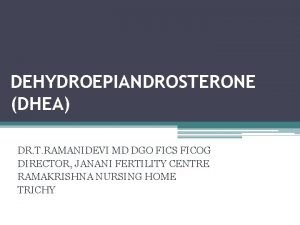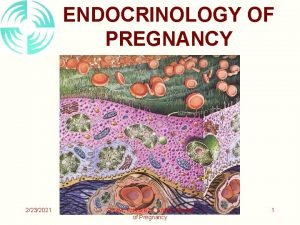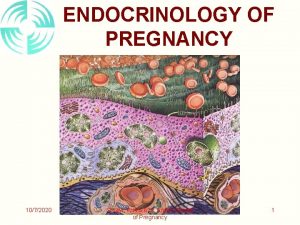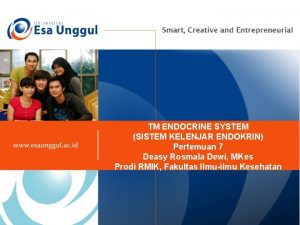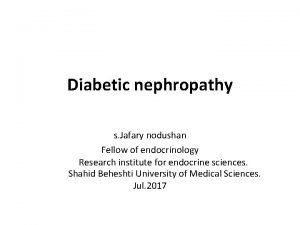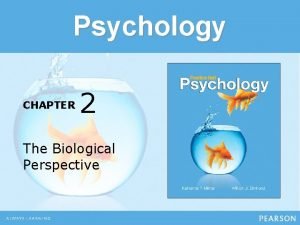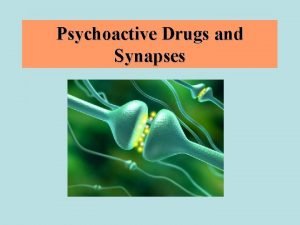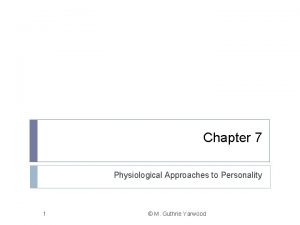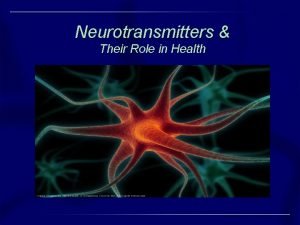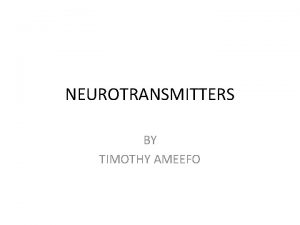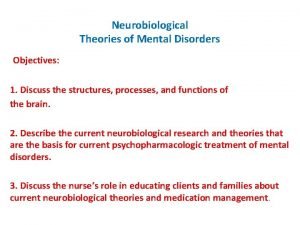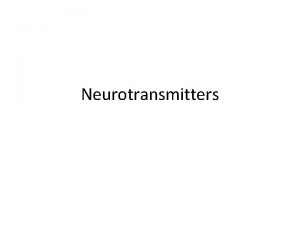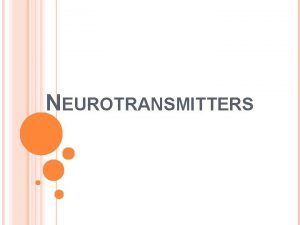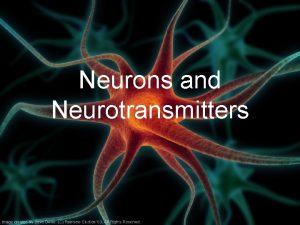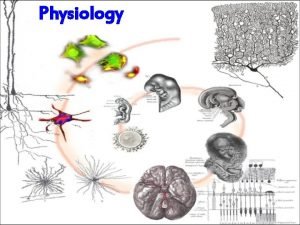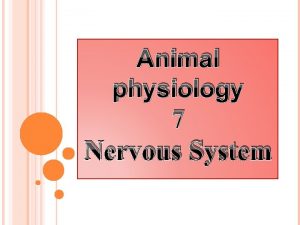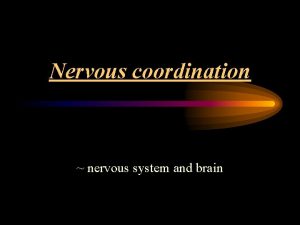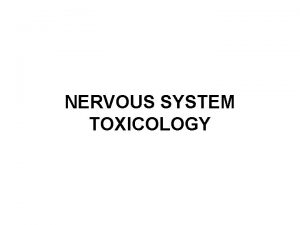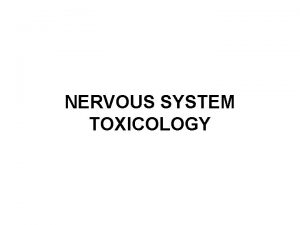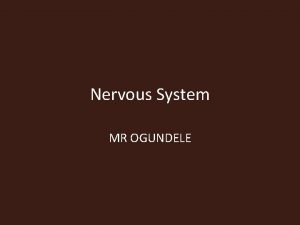ANIMAL PHYSIOLOGY AND ENDOCRINOLOGY Nervous System Physiology Neurotransmitters
























- Slides: 24

ANIMAL PHYSIOLOGY AND ENDOCRINOLOGY Nervous System Physiology: Neurotransmitters and synaptic transmission 9/30/2020 Zool 303 (Dr Saba Butt) 1

NEUROTRANSMITTERS Neurotransmitter is a chemical: I. it must be released from presynaptic terminal, ii. must elicit the normal depolarization, iii. The effect of the substance must be blocked by the same agents that block synaptic transmission. Neuromodulators alter or modify the functioning of synapses. Agonists are the chemicals that have the same effect as a neurotransmitter. Anatagonists are the chemicals that reduce or prevent the synaptic transmission. 9/30/2020 Zool 303 (Dr Saba Butt) 2

Table 4 -1. Selected Neurortransmitters and Neuromodulators Compound Site of Action of Neurons Acetylcholine Neuromuscular Junction, autonomic endings, autonomic ganglia, sweat glands, brain, retina, GI tract Biogenic amines Epinephrine Norephinephrine Dopamine Serotonin Histamine 9/30/2020 Brain, spinal cord Sympathetic endings, brain, spinal cord, GI tract Brain, Sympathetic ganglia, retina Brain, spinal cord, retina, GI tract Brain, GI tract Zool 303 (Dr Saba Butt) 3

Compound Site of Action of Neurons Amino acids GABA Glutamate Aspartate Glycine Brain, retina Brain Spinal cord, brain? Spinal cord, brain, retina Prines/Purine nucleotides Adenosine ATP Gas Nitric oxide 9/30/2020 Brain Autonomic ganglia, brain Brain, spinal cord, GI tract Zool 303 (Dr Saba Butt) 4

PRINCIPAL NEUROTRASMITTER SYSTEMS Following is a summarized overview of principal neurotransmitters and their receptors. ACETYLCHOLINE Acetylcholine is the principal neurotransmitter at neuromuscular junctions. The neurons that synthesize and release acetylcholine are called “cholinergic neurons”. 9/30/2020 Zool 303 (Dr Saba Butt) 5

9/30/2020 Zool 303 (Dr Saba Butt) 6

Active uptake 9/30/2020 Zool 303 (Dr Saba Butt) 7

ECITATORY AMINO ACIDS • Glutamate and aspartate are excitatory amino acids. These depolarizes many mammalian neurons. • Glutamate is calculated as responsible for 75 % excitatory transmission in brain and spinal cord. 9/30/2020 Zool 303 (Dr Saba Butt) 8

INHIBITROY AMINO ACIDS • Gamaamino Butyric Acid (GABA) and Glycine are inhibitory amino acid that act as neurotransmitters. • GABA is a major inhibitory neurotransmitter in the brain, where it is transmitter for 20 % synapses. It is also fund in retina. 9/30/2020 Zool 303 (Dr Saba Butt) 9

9/30/2020 Zool 303 - Dr Saba Butt 10

Figure 45 -1 Structure of a large neuron in the brain, showing its important functional parts. (Redrawn from Guyton AC: Basic Neuroscience: Anatomy and Physiology. Philadelphia: WB Saunders Co, 1987. ) 9/30/2020 Zool 303 - Dr Saba Butt 11

9/30/2020 Zool 303 - Dr Saba Butt 12

SYNAPTIC TRANSMISSION Synaptic transmission occur via two systems: – Electrical Synapses Electrical synapses are very closely connected channels between two neurons. It allows transmission of nerve impulse directly from one neuron to the other. – Chemical Synapses In chemical synapse, chemicals (neurotransmitters) are released at synapses and attach at other neuron’s receptors to transmit nerve impulse. 9/30/2020 Zool 303 - Dr Saba Butt 13

9/30/2020 Zool 303 - Dr Saba Butt 14

ELECTRICAL SYNAPSES • Electrical synapses transfer impulse by direct ionic coupling. • At electrical synapse, the plasma membranes of pre- and post-synaptic cells are in close apposition and communication between cells takes place by way of protein channels called GAP JUCTIONS. • Ions can flow from one cell to the other by way of these gap junction to produce an almost equal though somewhat attenuated signal in the postsynaptic cell. 9/30/2020 Zool 303 - Dr Saba Butt 15

ELECTRICAL SYNAPSES An Electron Micrograph showing CONNEXONS – channels in the membrane for Electrical Synapses. 9/30/2020 Zool 303 - Dr Saba Butt 16

In Electrical Synapses action potential directly transmit from presynaptic membrane to the postsynaptic membrane. 9/30/2020 Zool 303 - Dr Saba Butt 17

9/30/2020 Zool 303 - Dr Saba Butt 18

ØElectrical synapses were first discovered in 1959 in study on crayfish. ØElectrical transmission of nerve impulse is found at many locations in various animals, e. g. , vertebrate retina, some locations of vertebrate nervous system, smooth muscle and cardiac muscle fibers and sensory neurons. ØElectrical transmission is possible in both directions at gap junctions but at some places it is in only one direction, such junctions are called rectifying. 9/30/2020 Zool 303 - Dr Saba Butt 19

Ø Electrical transmission is quite faster than that of Chemical transmission due to the long pathway of chemical synapses, i. e. release of neurotransmitter – attachment of it to receptors at postsynaptic membrane – opening of ion channels in post synaptic membrane – generation of impulse. Ø At some locations both chemical and electrical transmission occur. It was first discovered in birds. 9/30/2020 Zool 303 - Dr Saba Butt 20

CHEMICAL SYNAPSES 9/30/2020 Zool 303 - Dr Saba Butt 21

Neuron – Neuron Synapse 9/30/2020 Zool 303 - Dr Saba Butt 22

Fast Chemical Synaptic Transmission -Neurotransmitter attaches to a receptor - Receptor is an ion channel, which opens in response - Ions flow inside. 9/30/2020 Zool 303 - Dr Saba Butt 23

Slow Chemical Transmission When the receptor is activated by the neurotransmitter, its G-protein site becomes receptive to the Gprotein. That protein moves into this interaction, which yields three major changes: (1) The GDP molecule is released and a GTP replaces it. (2) The alpha portion of the Gprotein dissociates from the beta moiety, and moves to connection with the gate molecule. (3) This causes the gate to open and an ionic current occurs. 9/30/2020 Zool 303 - Dr Saba Butt 24
 Preganglionic parasympathetic fibres
Preganglionic parasympathetic fibres Neuronal pool
Neuronal pool Nervous
Nervous What are neuron processes
What are neuron processes Reproductive biology and endocrinology
Reproductive biology and endocrinology Endocrinology of pregnancy
Endocrinology of pregnancy Endocrinology of pregnancy
Endocrinology of pregnancy Pediatric endocrinology near cameron park
Pediatric endocrinology near cameron park Adrenomegaly adalah
Adrenomegaly adalah Reproductive endocrinology near campbell
Reproductive endocrinology near campbell Endocrinology
Endocrinology Nervous system and digestive system
Nervous system and digestive system Adh function
Adh function Endocrine system vs nervous system
Endocrine system vs nervous system Neurotransmitters and their functions
Neurotransmitters and their functions Neurotransmitters and drugs
Neurotransmitters and drugs Neurotransmitters and personality
Neurotransmitters and personality General mechanism of hormone action
General mechanism of hormone action Unit 26 animal anatomy physiology and nutrition
Unit 26 animal anatomy physiology and nutrition Unit 26 animal anatomy physiology and nutrition
Unit 26 animal anatomy physiology and nutrition Psychology study design vcaa
Psychology study design vcaa To what extent can a damaged brain reorganize itself
To what extent can a damaged brain reorganize itself Serotonin excitatory
Serotonin excitatory List of neurotransmitters
List of neurotransmitters Inhibitory neurotransmitters
Inhibitory neurotransmitters




